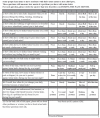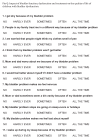The association between urinary continence and quality of life in paediatric patients with spina bifida and tethered cord
- PMID: 24421717
- PMCID: PMC3804643
The association between urinary continence and quality of life in paediatric patients with spina bifida and tethered cord
Abstract
Objective: To determine the association between urinary continence and quality of life (QoL) in a paediatric spina bifida population.
Methods: After appropriate ethics approval, a prospective study was initiated using multiple validated QoL instruments that were distributed to patients as they presented for their annual appointment at the Northern Alberta Spina Bifida Clinic (Edmonton, Alberta). General demographic information was collected and validated questionnaires were used. The survey package included two instruments to assess overall QoL: Global Pediatric QoL (PedsQL 4.0) and Health Specific QoL-Spina Bifida (HRQoL-SB). Two instruments were also included to quantify urinary symptoms and assess urinary specific QoL: the Urinary Incontinence Severity Index - Pediatric (ISI-P) and Urinary Specific QoL (PinQ).
Results: A total of 71 patients were enrolled in the study. The general QoL (PedsQL 4.0) and health-specific QoL (HRQoL-SB) scores for the population indicated an overall QoL of 66% (n=69) and 83% (n=67), respectively. Approximately 46% (33 of 71) reported >1 episode of urinary incontinence per week. Urinary continence was associated with a significantly higher urinary-specific QoL (PinQ; P<0.001), general QoL (PedsQL 4.0; P<0.05) and health-specific QoL (HRQoL-SB; P<0.05). Furthermore, urinary incontinence and its effect on QoL was not influenced by the presence of a shunt, level of the lesion or manner of dysraphism.
Conclusion: These data suggest that QoL in patients with spina bifida is related to urinary continence. This effect appears to be independent of the type and level of the spinal dysraphism and the presence or absence of a shunt.
Objectif: Déterminer l’association entre la continence urinaire et la qualité de vie (QdV) au sein de la population d’âge pédiatrique ayant un spina-bifida.
Méthodologie: Après l’approbation déontologique pertinente, les chercheurs ont amorcé une étude prospective au moyen de multiples instruments validés relatifs à la QdV, qui ont été distribués aux patients lors de leur rendez-vous annuel à la clinique de spina-bifida du nord de l’Alberta située à Edmonton, en Alberta. Ils ont colligé les renseignements démographiques généraux et utilisé des questionnaires validés. Le dossier de l’étude se composait de deux instruments pour valider la QdV globale : la QdV pédiatrique globale (PedsQL 4.0) et la QdV propre à la santé (HRQoL-SB). Deux instruments ont également été utilisés pour quantifier les symptômes urinaires et évaluer la QdV propre aux symptômes urinaires : l’indice de gravité de l’incontinence urinaire – pédiatrique (ISI-P) et la QdV propre aux symptômes urinaires (PinQ).
Résultats: Au total, 71 patients ont participé à l’étude. Les indices de QdV générale (PedsQL 4.0) et de QdV propre à la santé (HRQoL-SB) pour cette population ont indiqué une QdV globale de 66 % (n=69) et de 83 % (n=67), respectivement. Environ 46 % (33 sur 71) ont déclaré plus d’un épisode d’incontinence urinaire par semaine. La continence urinaire s’associait à une QdV propre aux symptômes urinaires, à une QdV générale et à une QdV propre à la santé nettement plus élevées (PinQ : P<0,001, PedsQL 4.0 : P<0,05 et HRQoL-SB : P<0,05, respectivement). Par ailleurs, la présence d’un shunt, le niveau de la lésion et la gravité de la dysraphie n’avaient pas d’influence sur l’incontinence urinaire et son effet sur la QdV.
Conclusion: Selon ces données, la QdV des patients ayant un spina-bifida est liée à la continence urinaire. Cet effet semble indépendant du type et du niveau de dysraphie spinale et de la présence ou de l’absence d’un shunt.
Keywords: Incontinence; Quality of life; Spina bifida.
Figures










References
-
- Boulet SL, Yang Q, Mai C, et al. Trends in the postfortification prevalence of spina bifida and anencephaly in the United States. Birth Defects Res A Clin Mol Teratol. 2008;82:527–32. - PubMed
-
- De Wals P, Tairou F, Van Allen MI, et al. Spina bifida before and after folic acid fortification in Canada. Birth Defects Res A Clin Mol Teratol. 2008;82:622–6. - PubMed
-
- Chamberlain MA, Kent RM. The needs of young people with disabilities in transition from paediatric to adult services. Eura Medicophys. 2005;41:111–23. - PubMed
-
- Dicianno BE, Kurowski BG, Yang JM, et al. Rehabilitation and medical management of the adult with spina bifida. Am J Phys Med Rehab. 2008;87:1027–50. - PubMed
-
- Guyatt GH, Feeny DH, Patrick DL. Measuring health-related quality of life. Ann Intern Med. 1993;118:622–9. - PubMed
LinkOut - more resources
Full Text Sources
Medical
